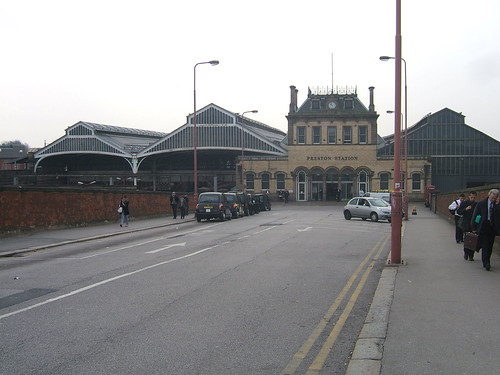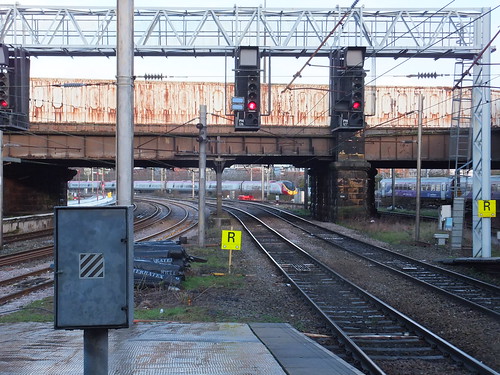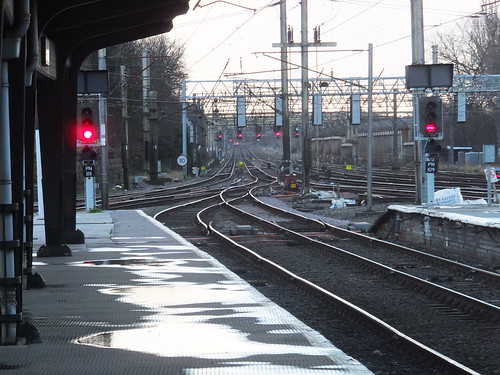My first taste of the railways around Preston was on trips to Blackpool by excursion train. I've described one trip I made in 1957 in the post Halfex to Blackpool. I was impressed - multiple running lines, large LNWR-style signal boxes and signal gantries with many dolls, some still sporting LNWR lower quadrant arms. Once I started work, I didn't find the same opportunities to take this sort of trip, particularly after I started working for myself in 1966.
But in the late 1960s, following an initial visit to Preston area by light aircraft chartered by my client (described in the post My First Flight), we secured a contract to supply digital selective call equipment for Lancashire Constabulary. This involved making a number of trips to Preston by train.
Later, in connection with the West Coast Mail Line Electrification Project, a new Power Signal Box controlling the Preston area was commissioned in 1972/1973. My firm supplied certain telecommunications equipment for this project (there's a short post about the development phase here) so, once again, I made a number of trips to Preston by train.
Since then, I've made various trips to or through Preston by both road or rail.
 Preston station in 2011: View from the station approach looking south. Left train shed is over platforms 7/6, central train shed is over platforms 5/4 and right train shed (with the end heavily rebuilt) is over platforms 3/2.
Preston station in 2011: View from the station approach looking south. Left train shed is over platforms 7/6, central train shed is over platforms 5/4 and right train shed (with the end heavily rebuilt) is over platforms 3/2.
 Preston: View looking north from platform 2 as an Up 'Pendolino' approaches.
Preston: View looking north from platform 2 as an Up 'Pendolino' approaches.
 Preston Station looking south with Bay platforms 4c and 3c in the foreground.
Preston Station looking south with Bay platforms 4c and 3c in the foreground.
History
Preston has a rather complex railway history. The notes below offer a simplified account.
The Preston & Wigan Railway received its Act in 1831 but, failing to attract sufficient financial support, it joined forces with the Wigan Branch Railway to form the North Union Railway. In 1838 its line was opened from Preston to Parkside, near Newton-le-Willows. This gave connections to the Liverpool and Manchester Railway (opened 1830) and the Grand Junction Railway (opened in 1837 and which, at the Birmingham end, linked to the London and Birmingham Railway). This was the start of Britain's railway network.
The next railway in Preston was a more modest affair. The Preston & Longridge Railway (opened 1840) was built mainly to ship stone from Longridge Fell for use in public buildings in Preston and for the construction of new docks in Liverpool. In the post Notes on Liverpool and its Docks I've written a little about the remarkable Jesse Hartley who was responsible for the high quality stonework provided in the expansion of Liverpool's Docks.
Extending north, the Lancaster and Preston Junction opened in 1840 but the North Union Railway initially made life very difficult by hampering through running. In the same year, the Preston & Wyre Railway, which sought to develop the Fylde area and complete a new port at the mouth of the River Wyre, opened its line. It, too, faced difficulties in through running to the North Union and both these lines opened their own, rather cramped, stations in Preston.
The Bolton and Preston Railway opened in 1843, sharing the North Union line for the 5.5 miles from Euxton Junction to Preston and offering a shorter journey from Preston to Manchester than via the North Union to Parkside and then via the Liverpool & Manchester. However, the high toll charged by the North Union for use of the shared line resulted in the North Union taking over the Bolton and Preston Railway the following year.
In 1844, both the Lancaster and Preston Junction and the Preston & Wyre trains were allowed to run into the North Union station. A direct line from Liverpool via Ormskirk to Preston was being promoted at the time, causing the North Union to feel threatened. It sought amalgamation with the Liverpool & Manchester and the Grand Junction, but these negotiations fell through. Instead, in 1846, it jointly leased its lines to the Manchester & Leeds and the Grand Junction, finally being absorbed in 1888 by the respective successors of the lessors the Lancashire & Yorkshire Railway and the London & North Western Railway.
In 1846, a joint North Union/Ribble Navigation Company branch was opened to Victoria Quay, involving a gradient of 1 in 29. The branch was extended to the new Preston Dock in 1892.
The Liverpool, Ormskirk & Preston Railway received assent in 1846 but was swiftly taken over by the East Lancashire Railway which had already absorbed the Blackburn & Preston. The East Lancashire Railway had problems with tolls charged for entering Preston from its long-gone connection at Farington particularly since, by this time, the lessors of the North Union were the London & North Western Railway and the Lancashire & Yorkshire Railway! The East Lancashire Railway promoted a Bill for its own route to Preston which was opposed by both the North Union and Preston Corporation. The final settlement involved landscaping near the Ribble and a difficult, curving approach to an expanded North Union station which opened in 1850. In 1859, the East Lancashire Railway amalgamated with the Lancashire & Yorkshire Railway which built new connections to Farington Curve Junction from the Liverpool Line (in 1891) and from Lostock Hall (in 1908).
By this time, congestion at the main station was causing many problems but it was not until 1880 that a new station was built, with further expansion in 1902.
Meanwhile, the West Lancashire Railway from Southport reached Preston in 1882 with its own terminus on Fishergate Hill. The railway's ambitious plans for the future were not fulfilled and in 1897 the Lancashire and Yorkshire Railway took over and constructed a new line to allow Southport trains to use the main station.

Click on image for larger view
1913 Railway Clearing House map of lines in the Preston area.
Signalling
Just before the second world war, two Westinghouse Style 'L' frames had been ordered, one to deal for the north end of the station, one for the south end. The war cancelled the project and most of the manual boxes struggled on until the present Preston Power Box took over in 1972/1973. One of the Style 'L' frames was used in the Euston resignalling but it was replaced quite soon by the Euston Power Box.
Of course, the manual signalling and the LNWR signal boxes which survived until the 1970s delighted me. I can remember standing on the Up main platform one evening waiting for a connection, just feet away from Preston No. 3 box. Every block bell could be heard clearly and I watched with interest every movement made by the signalman. Until Preston Power Signal Box was commissioned, these were the signal boxes on the main line approaching Preston from the south:-
Euxton Junction (84 lever)These signal boxes are detailed in the John Swift plans (in [2] below):- There were originally a number of other signal boxes on the various branches shown in the Railway Clearing House diagram above. The Southport - Preston lines were lost some time ago. I remember the sharply-curved East Lancashire line leaving Preston, but that too, was closed in 1972, freeing up valuable development land. Some of the signal boxes which dealt with East Lancashire line traffic are detailed in the John Swift plans (in [1] below):-
Euxton Coal Sidings (20 lever) Closed in 1965
Leyland (30 lever)
Bashalls Sidings Closed in 1965
Farington Junction (90 lever tappet)
Farington Curve Junction (30 lever)
Skew Bridge (36 lever)
Ribble Sidings (50 lever)
Preston No. 1 (162 lever)
Preston No. 1A (30 lever)
Preston No. 2A (69 lever overhead)
Preston No. 3 (38 lever)
Preston No. 4 (184 lever tappet)
Preston No. 5 (126 lever)
Lostock Hall Junction (40 lever)Trains to the East Lancashire line are now routed via the main line to Farington Curve Junction, then crossing over the main lines to reach Bamber Bridge. From Farington Curve Junction, the Liverpool line survives as a 'long siding' as far as Ormskirk where a change to Merseyrail allows passengers to complete their journey to Liverpool.
Lostock Hall Carriage Sidings
Lostock Hall Station
Lostock Hall Engine Shed
Moss Lane Junction
 Preston Power Signal Box, commissioned in 1972/1973.
Preston Power Signal Box, commissioned in 1972/1973.
Related articles on other websites
There's a lot of useful information on the website Preston Station - Past & Present.
Preston station is now managed by Virgin Trains and there are some particulars here.
There are a number of articles on Wikipedia:-
Preston Railway Station.Track Diagrams
London and North Western Railway
Preston and Wyre Joint Railway
Lancashire & Yorkshire Railway
East Lancashire Railway 1844–59
[1] ‘British Railways Layout Plans of the 1950’s - Volume 5: ex-Lancashire & Yorkshire Railway Lines in West Lancashire’ (ISBN: 1 873228 04 X).Books
[2] ‘British Railways Layout Plans of the 1950’s - Volume 6: West Coast Main Line (Euxton Junction to Mossband) and Branches’ (ISBN: 1 873228 00 7).
[3] ‘Railway Track Diagrams Book: 4 Midlands & North West’, published by TRACKmaps (ISBN 978-0-9549866-7-4).
Not all of these books feature Preston itself, but they all have information regarding lines and traffic flows in the Preston area:-
‘A Regional History of the Railways of Great Britain: Volume 10 The North West’ by G. O. Holt, revised Gordon Biddle published by David & Charles (ISBN: 0946537 34 8).Related Posts in this Blog
‘The Railways around Preston – An Historical Review’ by Gordon Biddle (Foxline Publishing 1989) ISBN 1 870119-05-3.
‘Rails to the Lancashire Coast’ by Richard Kirkman and Peter van Zeller, published by Dalesman Books (ISBN: 1 85568 027 0).
‘Railway Stations in the North West’ by Gordon Biddle, published by Dalesman Publishing Co. Ltd. (ISBN: 0 85206 644 9).???
‘Railways of the Fylde’ by Barry McLoughlin, published by Carnegie Publishing,1992 (ISBN 0-948789-84-0).
‘Railways to the Coast’ by Michael H. C. Baker, published by Patrick Stephens (ISBN 1-85260-058-6).???
‘Railways in East Lancashire’ by Martin Bairstow (self-published 1988) ISBN 0 9510302 8 0.
‘Lost Railways of Lancashire’ by Gordon Suggitt, published by Countryside Books (ISBN: 9 781853 068010).
Halfex to Blackpool (trip in 1957)
Railways around Blackpool (trip in 2014)
My Pictures
Railways around Preston
